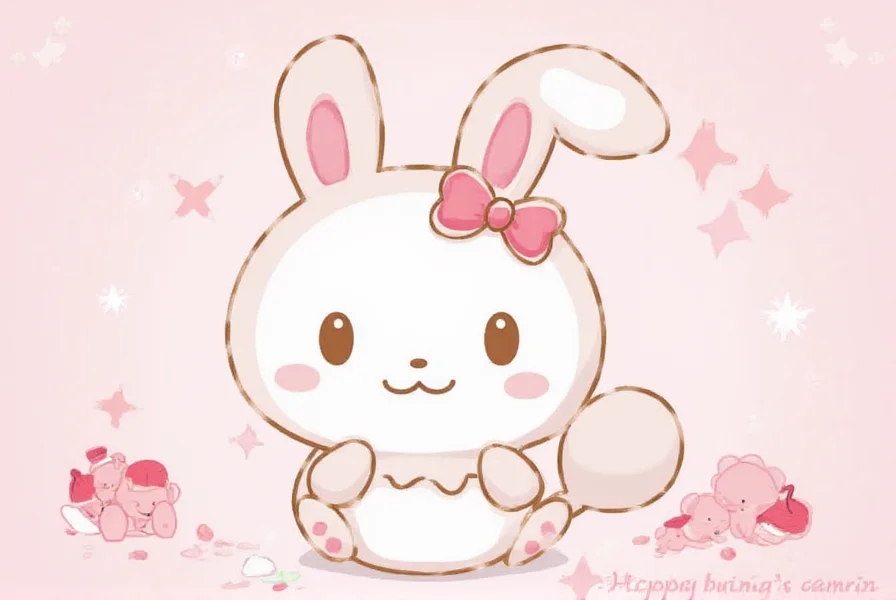Cinnamoroll represents Sanrio's mastery of creating emotionally resonant characters that capture hearts across generations. Unlike Hello Kitty who needs no backstory, Cinnamoroll comes with a rich narrative that enhances his appeal. Created by Yoshiko Yamaguchi, this character launched in 2001 as part of Sanrio's expansion beyond their flagship icon. His official birthday is March 6th, and he's known for his gentle personality, love of napping on clouds, and signature catchphrase "Roll~n".
The Origin Story of Sanrio's Cinnamon Roll Puppy
Sanrio developed Cinnamoroll during a strategic period when the company sought to diversify its character portfolio beyond Hello Kitty. The design team wanted a character that combined food motifs with animal features—a popular trend in Japanese kawaii culture. Cinnamon rolls represented warmth and comfort, while puppy characteristics conveyed loyalty and playfulness. This fusion created an instant classic that resonated particularly well in Asian markets before gaining global popularity.
Distinctive Physical Characteristics
Cinnamoroll's design contains several signature elements that make him instantly recognizable:
| Feature | Description | Significance |
|---|---|---|
| Ears | Swirled like cinnamon rolls | Enables flight and represents his namesake |
| Fur | Fluffy white with soft texture | Symbolizes purity and cloud-like softness |
| Eyes | Large sky-blue eyes | Conveys gentle, dreamy personality |
| Tail | Curled like a cinnamon roll | Reinforces food motif consistently |
These carefully designed elements work together to create a cohesive character that feels both familiar and unique within Sanrio's universe. Unlike many Sanrio characters who are anthropomorphic, Cinnamoroll maintains more puppy-like qualities while still expressing human emotions.
Personality and Backstory Development
Cinnamoroll's narrative depth sets him apart from many Sanrio characters. He lives in the sky at the "Cinnamon Cafe," where he delivers milk and desserts to cloud residents. His gentle nature sometimes makes him shy, but he's always willing to help others. This backstory gives fans multiple dimensions to connect with—the comfort of baked goods, the whimsy of sky-based adventures, and the relatable experience of overcoming shyness.
Sanrio has expanded Cinnamoroll's world through various media, including manga series and animated shorts that explore his relationships with other sky creatures. These stories emphasize kindness, friendship, and finding joy in simple pleasures—themes that resonate strongly with contemporary audiences seeking positive content.
Global Popularity and Cultural Impact
While initially popular in Japan and Asia, Cinnamoroll has gained significant international recognition in recent years. Several factors contribute to his growing global appeal:
- Universal comfort themes: His association with cinnamon rolls taps into cross-cultural comfort food associations
- Merchandise diversity: From high-end fashion collaborations to everyday stationery, products cater to various demographics
- Social media presence: Fan communities on Instagram and TikTok share creative Cinnamoroll content
- Emotional resonance: His gentle personality appeals to those seeking calming, positive imagery
Unlike some Sanrio characters that target specific demographics, Cinnamoroll attracts both children and adults. His aesthetic fits perfectly with contemporary trends like cottagecore and kawaii minimalism, explaining his presence in home decor, fashion, and even baking communities.
Building a Cinnamoroll Collection
For enthusiasts exploring authentic Cinnamoroll merchandise, understanding production eras helps identify valuable pieces. Early 2000s items often feature simpler designs with less articulation, while modern releases showcase more detailed sculpting and varied expressions. Limited edition collaborations with brands like Uniqlo and Porter Yoshida & Co. have created highly sought-after collector's items.
When building a collection, focus on official Sanrio products marked with proper copyright information. The character's 20th anniversary in 2021 spurred numerous special releases that remain popular among collectors today. Many fans appreciate how Cinnamoroll merchandise often incorporates practical functionality—like his popular bento boxes and kitchenware—blending cuteness with everyday utility.
Why Cinnamoroll Continues to Captivate Fans
Cinnamoroll's enduring popularity stems from his perfect balance of simplicity and depth. He represents comfort without being saccharine, cuteness with personality, and fantasy with relatable emotions. In today's fast-paced world, his gentle sky-based adventures offer a soothing escape that resonates across cultures.
Unlike trend-dependent characters, Cinnamoroll's design and themes have proven remarkably timeless. His association with comforting food motifs, combined with Sanrio's consistent storytelling, creates an emotional connection that keeps fans engaged for years. As Sanrio continues to develop new content and merchandise, Cinnamoroll remains positioned as one of their strongest secondary characters with significant growth potential worldwide.
Frequently Asked Questions
What is the real name of the cinnamon bun Sanrio character?
The character's official name is Cinnamoroll. He's a white puppy character created by Sanrio who debuted in 2001. His name combines "cinnamon" with "roll" to reflect his distinctive cinnamon roll-shaped ears that allow him to fly.
When was Cinnamoroll introduced by Sanrio?
Cinnamoroll was officially introduced by Sanrio in 2001 as part of their character expansion beyond Hello Kitty. His official birthday is March 6th, and he quickly became popular in Japan before gaining international recognition in subsequent years.
What makes Cinnamoroll different from other Sanrio characters?
Cinnamoroll stands out with his detailed backstory as a cloud cafe delivery puppy, his ability to fly using his cinnamon roll-shaped ears, and his gentle, slightly shy personality. Unlike many Sanrio characters who are primarily anthropomorphic, Cinnamoroll maintains more authentic puppy characteristics while still expressing human emotions.
Where can I find authentic Cinnamoroll merchandise?
Authentic Cinnamoroll products are available through official Sanrio channels including Sanrio boutiques, the Sanrio website, and authorized retailers like Amazon (sold by Sanrio), Uniqlo, and select department stores. Look for proper Sanrio copyright markings and avoid third-party sellers without verification to ensure authenticity.
Why is Cinnamoroll so popular among adult collectors?
Cinnamoroll appeals to adult collectors because of his soothing aesthetic, emotional depth, and versatile merchandise that blends cuteness with functionality. His gentle personality resonates with adults seeking comforting imagery, while Sanrio's collaborations with premium brands have created sophisticated collectibles that appeal to mature tastes beyond traditional kawaii merchandise.











 浙公网安备
33010002000092号
浙公网安备
33010002000092号 浙B2-20120091-4
浙B2-20120091-4